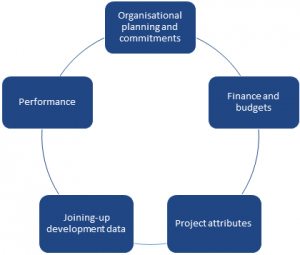Countdown to the Aid Transparency Index – Data collection starts in two days!
Having high quality, accessible and useful information about what is being spent where, by whom, and with what results is fundamental to making aid more effective. It also makes it more accountable to taxpayers in donor countries and citizens in countries receiving aid. Publish What You Fund’s Aid Transparency Index monitors the transparency of donors’ aid and development finance activities and encourages them to improve their levels of transparency.
We are now gearing up for the 2018 Index, set to be launched next June. We will begin to collect and monitor data from 45 donor agencies on 1st December 2017 and continue until 9th March 2018. As before, we will also engage with donors and independent reviewers during that time to be sure that the information we gather is accurate and our analysis and recommendations support organisations to make improvements to their data where possible.
This Index marks a change from previous reports. The 2016 Index primarily assessed donors’ progress towards meeting their commitments to transparency set in Busan in 2011. The 2018 Index methodology is even more robust and aims to encourage donor agencies to move beyond these commitments and improve the quality and usefulness of their data.
With publication comes responsibility
With the publication of data, however, also comes responsibility. This means, for example, that not only should the quality of data be consistently high and comprehensive enough to be useful. We also want donors to take steps to ensure the use of this data among representatives within donor agencies themselves, as well as to support key representatives in partner countries, including in government, parliament and civil society to access it and engage with it. Until this happens, this information cannot truly be used to ensure aid is accountable and effective.
To support this aim, Publish What You Fund embarked on a review of the Index methodology last year, consulting widely among relevant stakeholders. Information about this process and the changes made were outlined in our Guidelines paper, and full details of the methodology itself in our Technical paper.

Some of the changes include:
- The Index is now structured around five key components of aid transparency. This is to help make the rationale behind the methodology clearer for anyone who is less familiar with the IATI Standard.
- Greater weight is attached to some indicators, notably information on how a project performed (such as a review or evaluation document) and some specific indicators. These include sub-national locations, so it is possible to find out where projects are actually being undertaken within a country.
- We have increased the number of documents that we sample, to ensure consistency across the board and to get a better sense of how donors’ IATI data looks from a ‘user perspective.’
- We also incorporated titles and descriptions to the list of indicators sampled, to further encourage donor agencies to make sure that basic project information can be easily identified by anyone searching for this information.
Key Dates and Planning
- 15th January – First assessments following the initial round of data collection will be shared with donor organisations.
- 26th January – Deadline for feedback from donors on their initial assessment.
- 16th February – Independent reviewers for each agency feedback on these assessments.
- Early March – An updated assessment will be shared with donorsto give the opportunity to make any last improvements.
- 30th March -The final assessment will be available to donors, after data verification and standardisation.
- June 2018 – The full results will be released.
We encourage all donors to make sure that they upload final data as early as possible and contact us with any last queries well before the final deadline.
All engagement with donors will stop on 9th March as we turn our attention to analysing the final data.
We want to be able to answer donor agency questions about the process during the data collection period, but we are a small team assessing 45 agencies in great detail. This year we have tried to make the process more systematic, including sharing some of the key dates above to help agencies with planning.
As many of you will know, we developed and launched the Data Quality Tester (DQT), which is an online tool that enables agencies to check the quality of their data before they publish it to IATI. This is free to use and will allow organisations to work more independently to improve their publication. The DQT is available throughout the collection process (and in fact all year round) and we encourage organisations to use it as frequently as needed to test the quality of their data.
We look forward to working with everyone on a constructive Index process!

